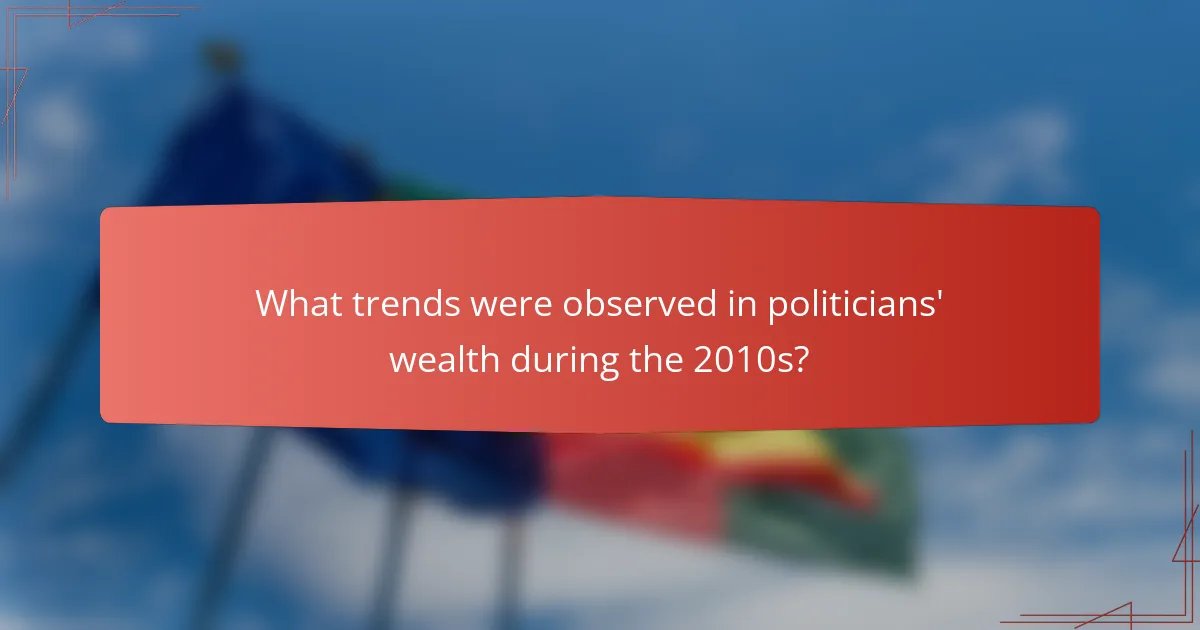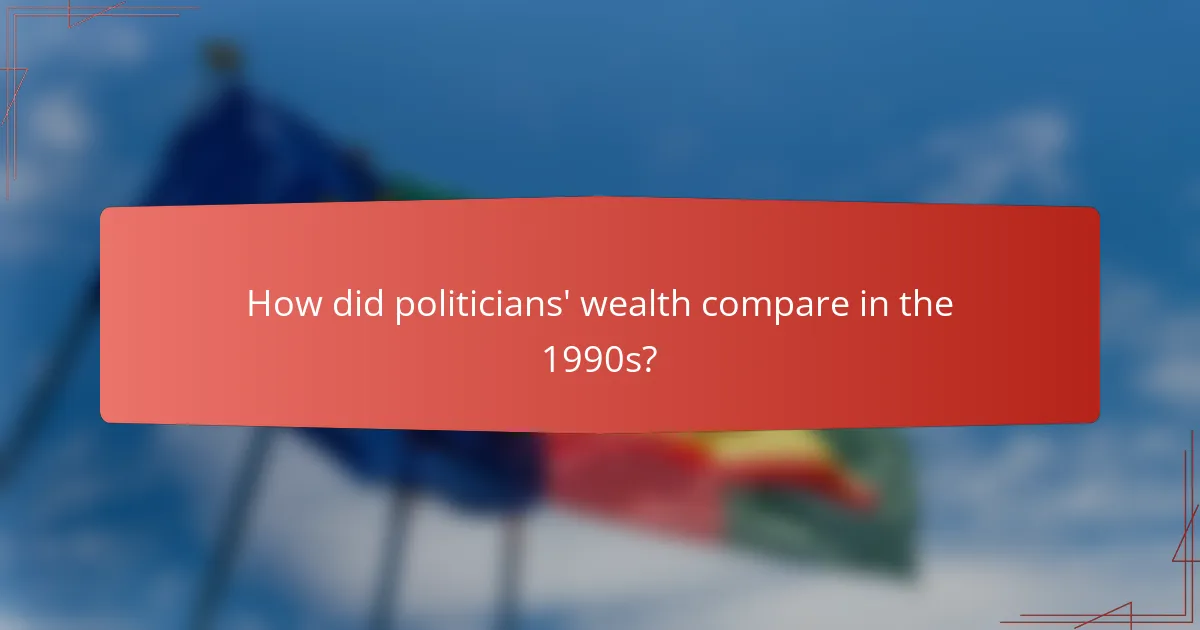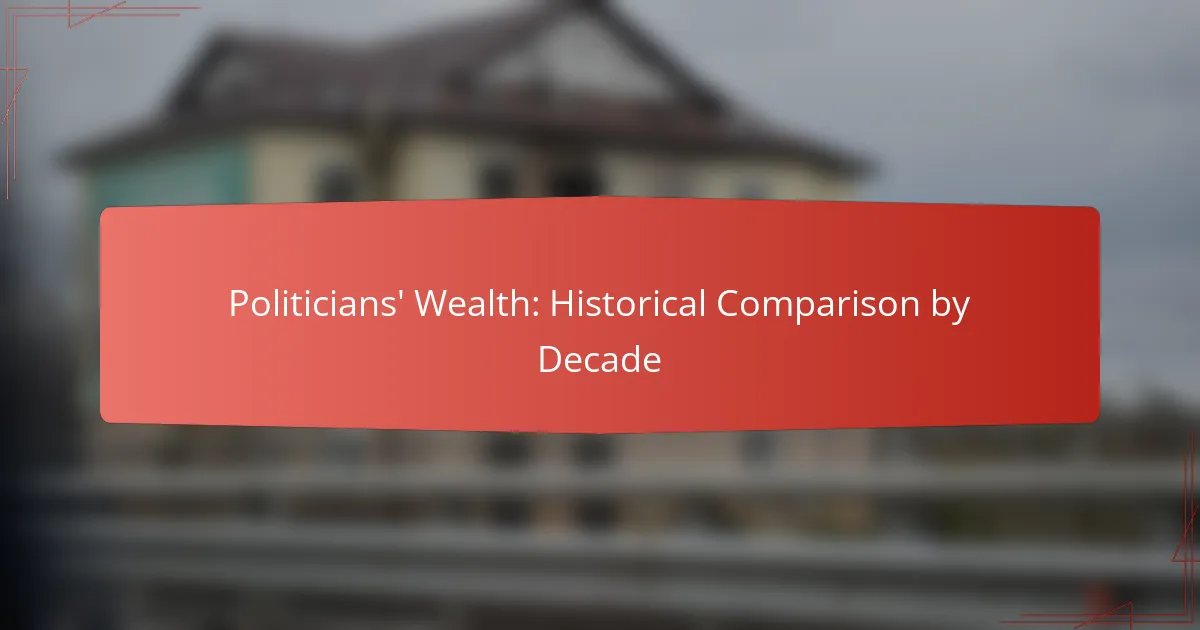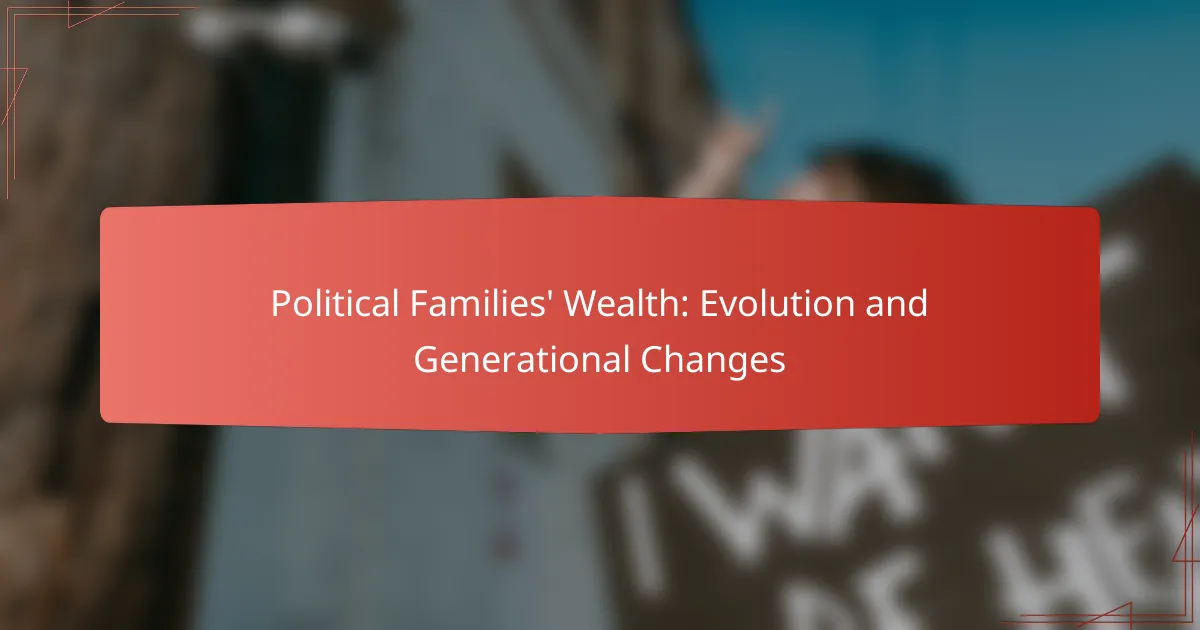The wealth of politicians has evolved significantly over the decades, reflecting changes in economic conditions, political landscapes, and fundraising practices. From the rise of billionaire politicians in the 2010s to the notable increases seen in the 2020s, each decade presents unique factors influencing the financial status of public officials. This historical comparison sheds light on the implications of wealth accumulation for governance and electoral dynamics.

How has politicians’ wealth changed in the 2020s?
In the 2020s, the wealth of politicians, particularly in the United States, has seen notable increases, reflecting broader economic trends and individual financial strategies. This shift raises questions about the implications of wealth accumulation among public officials and its impact on governance.
Increase in net worth among U.S. senators
U.S. senators have experienced significant increases in net worth during the 2020s, with many reporting assets in the low millions to tens of millions of dollars. This trend is often attributed to investments in real estate, stocks, and other ventures that have performed well in a recovering economy.
For instance, some senators have reported net worth increases of over 20% since the beginning of the decade, highlighting the financial benefits of their positions. This growth can lead to concerns regarding potential conflicts of interest and the influence of wealth on political decisions.
Impact of economic policies on wealth accumulation
The economic policies enacted during the 2020s have played a crucial role in shaping the wealth of politicians. Tax reforms, stimulus packages, and regulatory changes have created environments that can either enhance or hinder wealth accumulation for public officials.
For example, policies favoring capital gains can disproportionately benefit wealthy individuals, including politicians, allowing them to grow their assets more rapidly. Understanding these policies is essential for voters who wish to evaluate the motivations behind legislative decisions and their potential effects on wealth distribution.

What trends were observed in politicians’ wealth during the 2010s?
During the 2010s, a notable trend was the increasing presence of billionaire politicians, reflecting a shift in the political landscape. This decade also saw a significant correlation between personal wealth and campaign financing, influencing electoral dynamics and policy decisions.
Rise of billionaire politicians
The 2010s marked a surge in the number of billionaire politicians, with individuals like Donald Trump and Michael Bloomberg entering the political arena. Their substantial personal fortunes allowed them to self-fund campaigns, which changed traditional fundraising dynamics.
This rise has implications for political representation, as wealthier individuals may prioritize different issues compared to average constituents. The influence of billionaire politicians raises questions about equity in political power and access to decision-making processes.
Correlation with campaign financing
In the 2010s, the connection between politicians’ wealth and campaign financing became increasingly evident. Wealthy candidates could leverage their financial resources to dominate advertising and outreach, often outspending opponents significantly.
This trend has led to concerns about the impact of money on democracy, as campaigns funded by affluent individuals may prioritize the interests of the wealthy over those of the general population. Voters should be aware of how campaign financing shapes political agendas and candidate viability.

What were the key factors influencing politicians’ wealth in the 2000s?
In the 2000s, several key factors influenced politicians’ wealth, including economic conditions, regulatory changes, and the evolving landscape of political fundraising. The decade was marked by significant financial events and shifts in lobbying practices that directly impacted the financial status of many political figures.
Effects of the 2008 financial crisis
The 2008 financial crisis had a profound impact on politicians’ wealth, as it led to a significant decline in stock markets and property values. Many politicians with investments in these areas saw their net worth decrease sharply, while others who managed to navigate the crisis effectively may have increased their wealth through strategic investments.
During this period, public scrutiny of wealth disparities grew, prompting some politicians to advocate for financial reforms and increased regulation of the financial sector. This shift in focus also influenced how politicians approached their financial dealings, with many opting for more transparent practices to maintain public trust.
Changes in lobbying regulations
In the 2000s, lobbying regulations underwent notable changes, particularly following the 2006 Lobbying Disclosure Act amendments. These changes aimed to increase transparency and accountability in lobbying activities, which affected how politicians interacted with lobbyists and the financial benefits they could derive from these relationships.
As a result, politicians began to rely more on fundraising from individual donors and political action committees (PACs) rather than solely on lobbyist contributions. This shift altered the landscape of political financing, making it crucial for politicians to cultivate relationships with a broader base of supporters to maintain their wealth and influence.

How did politicians’ wealth compare in the 1990s?
In the 1990s, politicians’ wealth varied significantly, influenced by party affiliation and economic conditions. Many leaders saw their financial status rise due to booming markets and increased public interest in political careers.
Wealth distribution among party leaders
During the 1990s, wealth distribution among party leaders reflected broader economic trends and political dynamics. Leaders from the major parties, such as the Democratic and Republican parties in the United States, often had substantial personal fortunes, with some exceeding several million dollars.
For instance, prominent figures like Bill Clinton and Newt Gingrich showcased the financial advantages of political office, with their wealth stemming from a mix of salaries, book deals, and speaking engagements. This disparity in wealth often influenced party strategies and voter perceptions.
Impact of economic growth on political wealth
The economic growth of the 1990s had a profound impact on the wealth of politicians. The decade was marked by a significant expansion in the economy, leading to increased investment opportunities and higher income levels for many public officials.
As the stock market soared and technology companies flourished, politicians who capitalized on these trends often saw their net worth increase dramatically. This economic boom allowed some politicians to leverage their positions for lucrative opportunities, further widening the wealth gap within political circles.

What historical events shaped politicians’ wealth in the 1980s?
The 1980s were marked by significant shifts in the financial landscape for politicians, largely influenced by tax reforms and the rise of corporate donations. These factors not only altered the way politicians accumulated wealth but also impacted their relationships with constituents and businesses.
Influence of tax reforms
Tax reforms in the 1980s, particularly the Economic Recovery Tax Act of 1981, significantly reduced tax rates for individuals and corporations. This legislation allowed wealthier individuals, including politicians, to retain more of their income, leading to increased personal wealth among those in power.
Moreover, the reduction in capital gains tax rates incentivized investments, further enriching politicians who had access to financial markets. As a result, many politicians began to accumulate wealth through investments, real estate, and other financial ventures, which became more lucrative during this decade.
Growth of corporate donations
The 1980s saw a notable increase in corporate donations to political campaigns, driven by deregulation and the desire for favorable legislation. Corporations recognized the value of influencing political outcomes and began to allocate larger portions of their budgets to campaign contributions.
This influx of corporate money not only boosted the financial resources available to politicians but also created potential conflicts of interest. Politicians who accepted substantial donations often found themselves beholden to corporate interests, which could shape their policy decisions and priorities.

How did the 1970s affect politicians’ financial status?
The 1970s significantly impacted politicians’ financial status through economic challenges and changes in public service compensation. The decade was marked by inflation and recession, which influenced both the wealth accumulation of politicians and the perception of their financial integrity.
Economic downturn and its effects
The economic downturn of the 1970s, characterized by high inflation and unemployment, affected politicians’ financial status by limiting their investment opportunities and public perception. Many politicians faced scrutiny over their wealth as the public struggled with rising costs and stagnant wages.
During this period, the average inflation rate in the United States was around 7-8%, which eroded purchasing power and made it difficult for many to maintain their standard of living. Politicians who had previously enjoyed financial stability found themselves in a challenging environment, leading to increased public skepticism about their financial dealings.
Rise of public service salaries
In response to the economic challenges, many governments began to raise public service salaries in the late 1970s to attract and retain qualified individuals. This increase aimed to ensure that politicians and civil servants could maintain a reasonable standard of living despite economic pressures.
For instance, in the U.S., congressional salaries were adjusted to reflect the rising cost of living, moving from approximately $44,000 in the early 1970s to around $57,000 by the end of the decade. This shift not only impacted politicians’ financial status but also influenced public perceptions of their roles and responsibilities in a struggling economy.

What can we learn from politicians’ wealth trends over the decades?
Analyzing politicians’ wealth trends over the decades reveals significant insights into economic shifts and the influence of political power on personal fortunes. By understanding these trends, we can better grasp the relationship between governance and wealth accumulation.
Wealth Accumulation Patterns in the 20th Century
In the 20th century, politicians often saw their wealth grow alongside the expansion of government roles and economic opportunities. Many gained fortunes through investments, real estate, or business ventures, reflecting the economic climate of their times.
For instance, during the post-World War II era, increased government spending and infrastructure projects provided numerous opportunities for politicians to engage in lucrative contracts. This trend was particularly evident in countries like the United States, where politicians leveraged their positions for financial gain.
Shifts in Wealth Sources in the 21st Century
The 21st century has introduced new sources of wealth for politicians, including technology investments and global markets. As the digital economy has grown, many politicians have diversified their portfolios, often investing in tech startups or real estate in burgeoning markets.
Moreover, the rise of social media has allowed politicians to monetize their influence, creating new avenues for income. This shift highlights the importance of adaptability in wealth accumulation strategies, as traditional methods may no longer suffice.
Comparative Analysis of Wealth Trends by Region
Wealth trends among politicians can vary significantly by region, influenced by local economies, regulations, and cultural factors. In Europe, for example, politicians often face stricter regulations regarding financial disclosures, which can limit overt wealth accumulation compared to regions with fewer restrictions.
In contrast, politicians in emerging markets may experience rapid wealth growth due to less stringent regulations and burgeoning economies. Understanding these regional differences is crucial for analyzing the broader implications of political wealth trends.
Implications for Governance and Public Trust
The wealth trends of politicians can significantly impact public trust and perceptions of governance. When wealth accumulation appears disproportionate or linked to corruption, it can erode public confidence in political institutions.
To foster trust, transparency in financial dealings and clear regulations on political financing are essential. Citizens are more likely to support leaders who demonstrate integrity and accountability in their wealth management.



